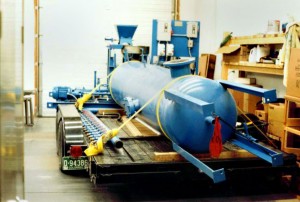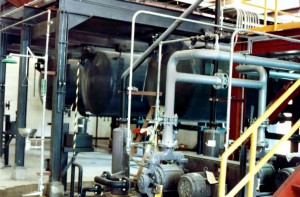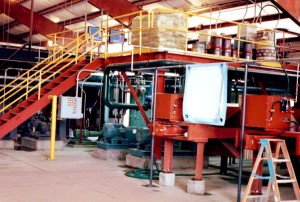Merrill Crowe Systems
The Merril-Crowe Gold recovery Process
The Merrill-Crowe gold recovery process removes precious metals from a cyanide solution by zinc precipitation.
The pregnant solution is first clarified through filters such as horizontal leaf type clarifiers. By using a precoat system (with diatomaceous earth) an extremely clear solution can be produced. The specific design criteria for these types of filters vary with the turbidity of the leach solutions. To avoid major upsets in the circuit, two filters should be online while another is being cleaned, precoated, and readied to go online as the next filter goes out of service. The solids removed by these filters are of no value and are backflushed to tails.
 The vacuum system removes oxygen from the solution in a packed tower. Solution is percolated through a packing bed while under a vacuum. Flashing water vapor strips oxygen from the solution. Special attention must be paid to eliminating any air leaking into the tower, as this can decrease the efficiency of the vacuum system. Solution exits from the bottom of the tower and results in a very low net suction head on the precipitate feed pumps. A careful selection of these pumps will avoid cavitation and the tendency to pull air back into the solution. It should also be noted that these pumps will require liquid seal in the packing area so that air does not leak into back solution. Zinc feed addition utilizes a zinc feeder with an auger and moving side walls to avoid bridging of the material. Using a cone bottom tank with a steady head tank for zinc mixing solution (usually a cyanide solution) will assure that no air will leak into the system. With a rich pregnant solution, the zinc will be better utilized, and conversely, with a weak pregnant solution it will be less utilized.
The vacuum system removes oxygen from the solution in a packed tower. Solution is percolated through a packing bed while under a vacuum. Flashing water vapor strips oxygen from the solution. Special attention must be paid to eliminating any air leaking into the tower, as this can decrease the efficiency of the vacuum system. Solution exits from the bottom of the tower and results in a very low net suction head on the precipitate feed pumps. A careful selection of these pumps will avoid cavitation and the tendency to pull air back into the solution. It should also be noted that these pumps will require liquid seal in the packing area so that air does not leak into back solution. Zinc feed addition utilizes a zinc feeder with an auger and moving side walls to avoid bridging of the material. Using a cone bottom tank with a steady head tank for zinc mixing solution (usually a cyanide solution) will assure that no air will leak into the system. With a rich pregnant solution, the zinc will be better utilized, and conversely, with a weak pregnant solution it will be less utilized.
 Using lead nitrate in the zinc system can activate the zinc. It must be used in low dosages to prevent blinding off the surface of the zinc and preventing precipitation of precious metals. An excessive use of lead nitrate can form a lead hydroxide gel and blind the filters.
Using lead nitrate in the zinc system can activate the zinc. It must be used in low dosages to prevent blinding off the surface of the zinc and preventing precipitation of precious metals. An excessive use of lead nitrate can form a lead hydroxide gel and blind the filters.
Zinc must be added at a constant rate. A variable speed feeder is recommended for this application. The zinc must be kept dry to keep it free flowing. The zinc solution is added to the line between the deaeration tower and the precipitate feed pumps.
Final filtration of the precious metals is accomplished with the precipitate filter feed pumps and filter presses. The feed pumps must have submerged liquid seals over the packing area or flushed double mechanical seals, and have a low NPSH requirement. Most filters are either the plate and frame type or the recessed plate type. Filter cake is collected in the chambers between the plates and can be air blown to remove a substantial amount of water.

